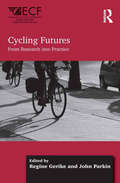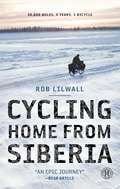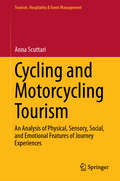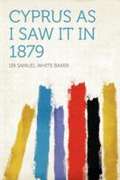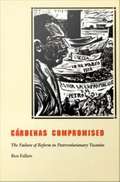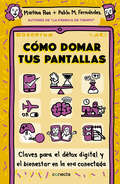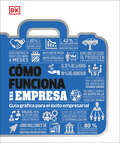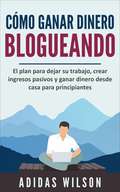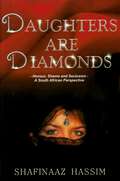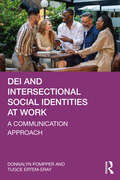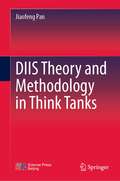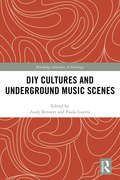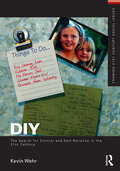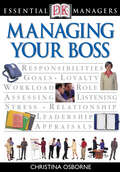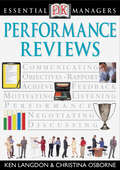- Table View
- List View
Cycling Futures: From Research into Practice
by John Parkin Regine GerikePointing the way to the future of research and development in relation to cycling as a mode of transport, this book investigates some of the significant recent developments in the technology, provision for, and take up of cycling in various parts of the world. Tensions at the heart of the nature of cycling remain: on the one hand cycling is frequently viewed as being a risky activity, while on the other hand it is seen as being a way of allowing populations to live healthier lives. Reviewing this dichotomy, the authors in this book consider the ways that cycling is planned and promoted. This is done partly in relation to these issues of risk and health, but also from the broader perspective of behavioural response to the changing nature of cycling. A section on methodologies is also included which outlines the current state-of-the art and points a way to future research.
Cycling Home from Siberia
by Rob Lilwall" It is late October, and the temperature is already -40 degrees . . . My thoughts are filled with frozen rivers that may or may not hold my weight; empty, forgotten valleys haunted by emaciated ghosts; and packs of ravenous, merciless wolves." Having left his job as a high-school geography teacher, Rob Lilwall arrived in Siberia equipped only with a bike and a healthy dose of fear. Cycling Home from Siberia recounts his epic three-and-a-half-year, 30,000-mile journey back to England via the foreboding jungles of Papua New Guinea, an Australian cyclone, and Afghanistan's war-torn Hindu Kush. A gripping story of endurance and adventure, this is also a spiritual journey, providing poignant insight into life on the road in some of the world's toughest corners.
Cycling Home from Siberia: 30,000 miles, 3 years, 1 bicycle
by Rob Lilwall" It is late October, and the temperature is already -40 degrees . . . My thoughts are filled with frozen rivers that may or may not hold my weight; empty, forgotten valleys haunted by emaciated ghosts; and packs of ravenous, merciless wolves." Having left his job as a high-school geography teacher, Rob Lilwall arrived in Siberia equipped only with a bike and a healthy dose of fear. Cycling Home from Siberia recounts his epic three-and-a-half-year, 30,000-mile journey back to England via the foreboding jungles of Papua New Guinea, an Australian cyclone, and Afghanistan's war-torn Hindu Kush. A gripping story of endurance and adventure, this is also a spiritual journey, providing poignant insight into life on the road in some of the world's toughest corners.
Cycling and Motorcycling Tourism: An Analysis of Physical, Sensory, Social, and Emotional Features of Journey Experiences (Tourism, Hospitality & Event Management)
by Anna ScuttariThis book explores the understanding, description, and measurement of the physical, sensory, social, and emotional features of motorcycle and bicycle journey experiences in tourism. Novel insights are presented from an original case study of these forms of tourism in the Sella Pass, a panoramic road close to the Dolomites UNESCO World Heritage Site. A comprehensive mixed-methods strategy was employed for this research, with concurrent use of quantitative and qualitative methods including documentation and secondary data analysis, mobile video ethnography, and emotion measurement. The aim was to create a holistic knowledge of the features of journey experiences and a new definition of the mobility space as a perceptual space. The book is significant in that it is among the first studies to explore the concept of journey experiences and to develop an interdisciplinary theoretical foundation of mobility spaces. It offers a comprehensive understanding and a benchmarking of the features of motorcycling and cycling journey experiences, a deeper market knowledge on motorcycling and cycling tourists, and a set of tools, techniques, and recommendations for future research on tourist experiences.
Cycling: A Sociology of Vélomobility (Changing Mobilities)
by Peter CoxCycling: A Sociology of Vélomobility explores cycling as a sociological phenomenon. Drawing on extensive ethnographic fieldwork, it considers the interaction of materials, competencies and meanings that comprise a variety of cycling practices. What might appear at first to be self-evident actions are shown to be constructed through the interplay of numerous social and political forces. Using a theoretical framework from mobilities studies, its central themes respond to the question of what it is about cycling that provokes so much interest and passion, both positive and negative. Individual chapters consider how cycling has appeared as theme and illustration in social theory, as well as the legacies of these theorizations. The book expands on the image of cycling practices as the product of an assemblage of technology, rider and environment. Riding spaces as material technologies are found to be as important as the machinery of the cycle, and a distinction is made between routes and rides to help interpret aspects of journey-making. Ideas of both affordance and script are used to explore how elements interact in performance to create sensory and experiential scapes. Consideration is also given to the changing identities of cycling practices in historical and geographical perspective. The book adds to existing research by extending the theorization of cycling mobilities. It engages with both current and past debates on the place of cycling in mobility systems and the problems of researching, analyzing and communicating ephemeral mobile experiences.
Cyprus, as I Saw It in 1879
by Sir Samuel White BakerCyprus was placed under British control in 1878 as a result of the Cyprus Convention, which granted control of the island to Britain in return for British support of the Ottoman Empire in the Russian-Turkish War. Little was known about the country at the time and this work is the result of a visit by Baker, an English explorer and author, in 1879.
Czechs, Slovaks and the Jews, 1938–48: Beyond Idealisation and Condemnation
by Jan LáníčekCovering the period between the Munich Agreement and the Communist Coup in February 1948, this groundbreaking work offers a novel, provocative analysis of the political activities and plans of the Czechoslovak exiles during and after the war years, and of the implementation of the plans in liberated Czechoslovakia after 1945.
Cárdenas Compromised: The Failure of Reform in Postrevolutionary Yucatán
by Ben FallawCrdenas Compromised is a political and institutional history of Mexico's urban and rural labor in the Yucatn region during the regime of Lzaro Crdenas from 1934 to 1940. Drawing on archival materials, both official and popular, Fallaw combines narrative, individual case studies, and focused political analysis to reexamine and dispel long-cherished beliefs about the Cardenista era. For historical, geographical, and ethnic reasons, Yucatn was the center of large-scale land reform after the Mexican Revolution. A long-standing revolutionary tradition, combined with a harsh division between a powerful white minority and a poor, Maya-speaking majority, made the region the perfect site for Crdenas to experiment by launching an ambitious top-down project to mobilize the rural poor along ethnic and class lines. The regime encouraged rural peasants to form collectives, hacienda workers to unionize, and urban laborers to strike. It also attempted to mobilize young people and women, to challenge Yucatn's traditional, patriarchal social structure, to reach out to Mayan communities, and to democratize the political process. Although the project ultimately failed, political dialogue over Crdenas's efforts continues. Rejecting both revisionist (anti-Crdenas) and neopopulist (pro-Crdenas) interpretations, Fallaw overturns the notion that the state allowed no room for the agency of local actors. By focusing on historical connections across class, political, and regional lines, Fallaw transforms ideas on Cardenismo that have long been accepted not only in Yucatn but throughout Mexico. This book will appeal to scholars of Mexican history and of Latin American state formation, as well as to sociologists and political scientists interested in modern Mexico.
Cómo Ser un Minimalista Digital: Simplifique su Vida y Elimine el Desorden Utilizando la Tecnología
by Dan Gaines¿Está buscando simplificar su vida? ¿Está buscando reducir o eliminar el desorden? ¿Está buscando ahorrar dinero? Si respondió sí a cualquiera de estas preguntas, ¡Esta guía es para usted! Aprenda los pasos esenciales sobre cómo usar el minimalismo digital para simplificar su vida. No solo eso, sino que aprenderá a: - Ahorrar dinero eliminando gastos innecesarios. - Ahorrar tiempo organizando su vida. - Ahorrar molestias eliminando el desorden. - Ser más feliz y tener una mente clara. ¡Esto y mucho más cuando haga clic en el botón "Comprar ahora" para comenzar con el minimalismo digital y mejorar su vida! Descargo de responsabilidad: Este autor y/o propietario(s) de los derechos no hacen reclamos, promesas o garantías sobre la exactitud, integridad o adecuación de los contenidos de este libro, y expresamente renuncia a la responsabilidad por errores y omisiones en los contenidos. Este producto es solo para ser usado como referencia.
Cómo domar tus pantallas: Claves para el détox digital y el bienestar en la era conectada
by Martina Rua Pablo Martín FernándezEl nuevo libro de dos de los especialistas más reconocidos de la Argentina sobre varios de los temas fundamentales del presente y nuestro futuro inmediato: el impacto de la economía de la atención en nuestras vidas, los nuevos conocimientos necesarios para la organización del trabajo remoto y presencial y una administración equilibrada del uso de la tecnología digital. Justo en el momento en que empezábamos a entender cómo mejorar nuestra relación con las pantallas -la del celular, la computadora, el streaming- se desató una pandemia que cambió de la noche a la mañana nuestro día a día. Justo cuando el home office empezaba a ser una posibilidad real y tentadora para muchos, el destino lo impuso con fuerza y sin preguntar en las existencias de quienes trabajan o estudian. Hoy sabemos que el trabajo será cada vez más remoto y digital y que las plataformas tendrán un impacto mayor en nuestras vidas. Será necesario adquirir distintas habilidades, y ya nos aquejan nuevos malestares: la misma tecnología que nos abrió un mundo de posibilidades puede abrumarnos. ¿Cómo desconectarnos si el trabajo vive en la misma pantalla que nos mantiene comunicados con familiares y amigos? ¿Cómo trazar límites? En otras palabras, ¿cómo recuperar el control de nuestras vidas? Frente a estos nuevos desafíos y con el mismo espíritu de taller de La fábrica de tiempo, Martina Rua y Pablo Martín Fernández nos acercan en Cómo domar tus pantallas las ideas más actuales y potentes para el desarrollo de un entorno saludable, de bienestar digital y trabajo productivo. Una verdadera caja de herramientas -con técnicas, ejercicios prácticos y las experiencias directas de figuras tan diversas como Carl Honoré, Narda Lepes y Juan Pablo Varsky- que nos ayudarán a alcanzar un equilibrio en el uso de nuestras pantallas y el tiempo que les dedicamos. Es decir, a reordenarnos, de cara a los cambios que ya estamos experimentando y a los que vendrán, para vivir mejor. «Martina y Pablo nos proponen replantear las bases mismas con las que nos pensamos en relación con los teléfonos inteligentes, los dispositivos y las aplicaciones, un paso fundamental para dejar atrás lo peor de la 'vieja normalidad' y encarar con mayor franqueza lo que vendrá».Tomás Balmaceda A través de un estilo dinámico y accesible forjado en la infinidad de charlas y talleres que ofrecen desde hace años y siguen dando con éxito en Argentina, Latinoamérica y España, Martina y Pablo abordan temas esenciales relacionados con los mayores desafíos del presente, fuente de consultas y ansiedades laborales, sociales y personales.
Cómo funciona una empresa: Guía gráfica para el éxito empresarial (DK How Stuff Works)
by Alexandra BlackUn máster empresarial en una práctica guía ilustrada¿Por qué el flujo de efectivo es tan importante? ¿En qué consiste la producción ágil? ¿Cómo funciona el marketing digital? ¿Quién forma parte del consejo ejecutivo?Cómo funciona una empresa explica los conceptos clave de la empresa mediante atractivos gráficos y un lenguaje sencillo y alejado de tecnicismos. Constituye una excelente introducción para estudiantes de estudios empresariales, personas que desee conocer las bases de los negocios sin hacer un MBA y empresarios que deseen tener éxito en el mercado global del siglo XXI.SOBRE LOS AUTORESEl Dr. Julian Sims se incorporó al mundo académico tras una exitosa carrera empresarial en Estados Unidos y el Reino Unido. Es profesor de Dirección de Empresas en Birkbeck, Universidad de Londres, censor jurado de cuentas y profesional colegiado de tecnologías de la información. Ha publicado un gran número de artículos en revistas académicas.Philippa Anderson es escritora de temas empresariales y consultora de comunicación, y ha trabajado como asesora de distintas multinacionales, entre las que están 3M, Anglo American y Coca-Cola.Alexandra Black estudió comunicación empresarial y ha sido periodista del diario financiero del grupo Nikkei Inc. en Japón. En su etapa en Tokio fue editora de la división de análisis de riesgos del banco de inversión JP Morgan.Joe Stanley-Smith es periodista de la International Tax Review en Londres, donde está especializado en impuestos indirectos y litigios fiscales. Se graduó en periodismo, en la especialidad de información empresarial, por la Universidad de Kingston, Reino Unido.
Cómo ganar dinero blogueando: El plan para dejar su trabajo, crear ingresos pasivos y ganar dinero desde casa para principiantes
by Adidas WilsonLos blogs comenzaron como revistas en línea donde las personas compartían sus vidas. Pero hoy, los objetivos son más profesionales. La mayoría de las personas ahora bloguea para promocionar su negocio o marca. Esta publicación destaca razones comunes para los blogs y los beneficios. A las personas les encanta compartir lo que les apasiona. Si te encanta pescar, querrás contarle al mundo entero al respecto. Esto se aplica a otras cosas como marketing, fotografía, etc. Bloguear sobre lo que amas te ayuda a conectarte con otras personas que comparten tu pasión, en todo el mundo. Un blog te brinda una plataforma para enseñar a otros. Al hacerlo, también aprenderá más sobre el tema. Educar a través de un blog puede abrir un flujo de ingresos para usted. Los blogs para dueños de negocios aumentan la exposición. El contenido regular del blog le permite visibilidad en los resultados de búsqueda de Google. Y si crea contenido para otros sitios web, expondrá su negocio a una nueva audiencia. Compartir lo que sabes a través de un blog hace que las personas te vean como una autoridad. Si elige un nicho específico, puede comenzar a ser invitado a hablar en eventos, podcasts y entrevistas.
DAUGHTERS ARE DIAMONDS
by Shafinaaz HassimDaughters are Diamonds is a ground breaking treatise on the objectification of women in honour-bound sectors of society. As a study, it sets out to define these questions: How are the opportunities, challenges and obstacles facing South African Indian Muslim women within the family, perceived and experienced by the individual? To what extent, if at all, does traditionalist culture create/influence a gap between opportunity and achievement for South African Indian Muslim women? The statement that "women are diamonds" is often used by Indian Muslim traditionalists to justify the abject seclusion of women. In this view, that which is valuable should be hidden in safekeeping. The metaphor of the diamond is used to illustrate the objectification of daughters borne of honour-bound societies, and the limits put to the administration of their lives, in keeping with the code of honour. This study is a comment on the notion that, in keeping with this honour code, there is a fine line between maintaining the dignity of a people and infringing on the rights of the individual. It also asks whether women are able to carve out a space for themselves within which a fully reflexive life may be lived in spite of the restrictions placed on them.
DEI and Intersectional Social Identities at Work: A Communication Approach
by Donnalyn Pompper Tugce Ertem-ErayThis book equips readers—both students and communication practitioners—with the theoretical understanding and practical skills they need to support nonprofit and for-profit organizations to create and assess their diversity, equity, inclusion (DEI), and social identity intersectionality goals.Through applied examples of the insider activist role that the communication function plays, the book helps future and current professional communicators navigate organizations toward authentic relationship-building with internal and external audiences. It teaches that embracing DEI includes acknowledging social identity intersectionalities—recognizing that people possess multiple social identity dimensions of age, culture, ethnicity/race, faith/spirituality, gender, physical/psychological ability, sexual orientation, social class, and more. In order to illuminate the theory discussed in the book, each chapter includes thought-provoking situation-opportunity sidebars, discussion questions for drilling deeper into the issues at hand, and case studies with applied lessons about DEI issues.This is an ideal text for advanced undergraduates and graduate courses in organizational communication, strategic communication, marketing communication, human resources, and public relations, as well as for communication practitioners working in these subdisciplines.
DIIS Theory and Methodology in Think Tanks
by Jiaofeng PanThis book provides the readers with the overall latest research on think tanks, summarizing the characteristics of think tanks, revealing the general laws and internal logic of think tank research, applying systems, dialectical views and operations research, system theory, and cybernetics to the problems existing in the research work of think tanks at home and abroad. Based on problem-oriented, evidence-oriented and scientific orientation, this book systematically considers the methodology of think tank research, proposes the DIIS theoretical method system of think tank research, defines the standardization process of think tank research and the quality standard of think tank DIIS, and gives corresponding DIIS to the actual think tank research problem. The method aims to improve the scientificity, effectiveness, and reliability of the research results of think tanks, provide systematic theoretical analysis for think tank research, promote the professional development of think tanks, and better serve the modernization of national governance systems and governance capabilities. This book presents new theoretical and research method support and reference that contribute to macro decision-making departments, management departments, scientific research institutes, universities, and enterprises think tank research related departments, strategic decision makers, think tank managers, think tank researchers, and readers interested in think tanks reading and using. Finally yet importantly, this book embodies the research of think tank as the object of investigation, jumping out of specific social conditions, using systemic thoughts, thinking about the more general role and characteristics of think tanks from the theoretical level, important theoretical issues such as principles and logic systems that think tank research should follow.
DIVERSITY, EQUITY AND INCLUSION: CREATING VALUE-BASED SUSTAINABLE ORGANIZATIONS
by Sunita Singh Sengupta Suresh Kalagnanam P. Jyothi B. CharumathiThe benefits of high integrity and high-responsibility organizations are well[1]established conscience mechanisms based on the principles of inclusion that emphasize justice, care, and fair practices at workplaces. Superrich Amazon investor Nick Hanauer writes in Oxfam’s state of wealth inequality report published on Monday (January 21, 2019) “I am a practitioner of capitalism,” … The most important lesson I have learned from these decades of experience with market capitalism is that morality and justice are the fundamental prerequisites for prosperity and economic growth (Singh Sengupta, 2021). When leaders and organizations operate from a deep awareness of their consciousness—they naturally behave responsibly beyond what appears to be their own self-interest…The managers who integrate spiritual values with their managerial styles in the entire operations management system bring integrity and oneness to the organizations…
DIY Cultures and Underground Music Scenes (Routledge Advances in Sociology)
by Andy Bennett Paula GuerraThis volume examines the global influence and impact of DIY cultural practice as this informs the production, performance and consumption of underground music in different parts of the world. The book brings together a series of original studies of DIY musical activities in Europe, North and South America, Asia and Oceania. The chapters combine insights from established academic writers with the work of younger scholars, some of whom are directly engaged in contemporary underground music scenes. The book begins by revisiting and re-evaluating key themes and issues that have been used in studying the cultural meaning of alternative and underground music scenes, notably aspects of space, place and identity and the political economy of DIY cultural practice. The book then explores how the DIY cultural practices that characterize alternative and underground music scenes have been impacted and influenced by technological change, notably the emergence of digital media. Finally, in acknowledging the over 40-year history of DIY cultural practice in punk and post-punk contexts, the book considers how DIY cultures have become embedded in cultural memory and the emotional geographies of place. Through combining high-quality data and fresh conceptual insights in the context of an international body of work spanning the disciplines of popular-music studies, cultural and media studies, and sociology the book offers a series of innovative new directions in the study of DIY cultures and underground/alternative music scenes. This volume will be of particular interest to undergraduate students in the above-mentioned fields of study, as well as an invaluable resource for established academics and researchers working in these and related fields.
DIY Detroit: Making Do in a City without Services
by Kimberley KinderFor ten years James Robertson walked the twenty-one-mile round-trip from his Detroit home to his factory job; when his story went viral, it brought him an outpouring of attention and support. But what of Robertson&’s Detroit neighbors, likewise stuck in a blighted city without services as basic as a bus line? What they&’re left with, after decades of disinvestment and decline, is DIY urbanism—sweeping their own streets, maintaining public parks, planting community gardens, boarding up empty buildings, even acting as real estate agents and landlords for abandoned homes.DIY Detroit describes a phenomenon that, in our times of austerity measures and market-based governance, has become woefully routine as inhabitants of deteriorating cities &“domesticate&” public services in order to get by. The voices that animate this book humanize Detroit&’s troubles—from a middle-class African American civic activist drawn back by a crisis of conscience; to a young Latina stay-at-home mom who has never left the city and whose husband works in construction; to a European woman with a mixed-race adopted family and a passion for social reform, who introduces a chicken coop, goat shed, and market garden into the neighborhood. These people show firsthand how living with disinvestment means getting organized to manage public works on a neighborhood scale, helping friends and family members solve logistical problems, and promoting creativity, compassion, and self-direction as an alternative to broken dreams and passive lifestyles.Kimberley Kinder reveals how the efforts of these Detroiters and others like them create new urban logics and transform the expectations residents have about their environments. At the same time she cautions against romanticizing such acts, which are, after all, short-term solutions to a deep and spreading social injustice that demands comprehensive change.
DIY: The Search For Control And Self-reliance In The 21st Century (Framing 21st Century Social Issues)
by Kevin WehrFrom the driveway mechanic to the backyard gardener, many diverse people are "doing it themselves" by building or repairing the stuff of their daily lives without the aid of experts. Do It Yourself uses Habermas’s colonization of the lifeworld as a frame and mobilizes Marx’s concepts of alienation and mystification to examine how social behaviors can be a conscious reply to a complex and fast-moving world, a nostalgia for simpler times past, or a just an economic impulse. Each main chapter is anchored by an extended empirical example: back-to-the-land, home-schooling, and self-government.
DIY: The Wonderfully Weird History and Science of Masturbation
by Eric SprankleThe first-ever social and scientific history of masturbation, which unapologetically critiques a system that has sought to control the very human desire for self-pleasure. Despite decades of medical and psychological research confirming that masturbation is healthy, the act remains shrouded in taboo and pseudoscience. In DIY, Dr. Eric Sprankle reveals the untold story of crusaders on a long campaign to suppress masturbation and the sex educators fighting back with science. He introduces readers to a colorful cast of characters: doctors advocating for the use of chastity devices, wellness influencers who believe ejaculation depletes the body of vital nutrients, pastors who preach that masturbation creates mermaids, and vibrator aficionados who teach the curious how to come. DIY will challenge what you think you know about the very human need for self-pleasure. Part sex-positive exposé, part fascinating science, DIY spotlights generations of sex education countering anti-masturbation pseudoscience with empowering truths about pleasure. This sex book is perfect for fans of Mary Roach books like Bonk or anyone curious about the history of sex and masturbation.
DK Essential Managers: Balancing Work and Life (DK Essential Managers)
by Robert Holden Ben RenshawThis practical guide will help you manage your career and your personal life to achieve both success and happiness. It balances detail and accessibility to make for a read that is concise as well as comprehensive.Written by Robert Holden, a psychologist and stress expert, and Ben Renshaw, a leadership coach and therapist. They are co-directors of The Happiness Project, and each have authored several books, including Holden's Be Happy and Crenshaw's Lead. Part of the DK Essential Managers series. Packed with essential tips for today's competitive business world, these efficient guidebooks are ideal for anyone interested in improving their business skills. Concise treatment of dozens of techniques, skills, and methods make Essential Managers the most accessible guide to business available.
DK Essential Managers: Managing Your Boss (DK Essential Managers)
by Christina OsborneEvery manager is stuck between their employees and their boss — but if you learn the right techniques, management works in both directions. You can be effective in your job if you learn to manage your boss. Know what you want in your career, and assess what you need from your own supervisor, so that you can work jointly to reach your goals. You will find that it is easier to advance your own goals when you develop a better, cooperative relationship, and your boss will find that their own productivity increases as well. The whole team will be better off. With clear, practical steps, Managing Your Boss manages to makes this difficult process accessible and achievable. The DK Essential Managers series covers a range of business and management topics and has sold more than two million copies worldwide. Each guide is clearly presented for ease of reference, with visual pointers, tips, and graphics.
DK Essential Managers: Performance Reviews (DK Essential Managers)
by Ken Langdon Christina OsborneLearn everything you need to know to evaluate and enhance staff performance. This helpful guide explains how to prepare and conduct an appraisal session and how to follow up with effective action plans. Practical techniques demonstrate how to motivate your staff, and power tips help you to handle real-life situations and develop the skills to build a committed team. The Essential Managers have sold more than 2 million copies worldwide! Experienced and novice managers alike can benefit from these compact guides. The topics are relevant to every work environment, from large corporations to small businesses. Concise treatments of dozens of business techniques, skills, methods, and problems are presented with hundreds of photos, charts, and diagrams. It is the most exciting and accessible approach to business and self-improvement available.
DK Essential Managers: Positive Thinking (DK Essential Managers)
by Susan QuilliamPositive thinking can help you realize your goals, but for most people, it&’s a skill that has be learned and practiced regularly. This book uses expert tips, clear text, and hard-working illustrations to show you how to assess your thinking patterns and change your negative perceptions in order to live a confident, fulfilled life.From helping you identify areas that have negativity in your life, to guiding you through rethinking negative beliefs, to learning new mental and emotional strategies, this book will help you transform your approach to living. Self-assessment exercises enable you to evaluate your positivity. The guide then helps you apply these fundamental lessons to your life — in the workplace, in your love life, for health, at play, and in friendship. A solid foundation of positivity will help you get the best from life.The DK Essential Managers series covers a range of business and management topics and has sold more than two million copies worldwide. Each guide is clearly presented for ease of reference, with visual pointers, tips, and graphics.
DOCTOR TO DOCTOR: Success Strategies Elevating Your Business & Personal Life
by Emily LetranThis book is a compilation of strategies for success covering multiple disciplines, such as medicine, dentistry, optometry, chiropractic, philosophy and pharmacy. We believe in the unity of health care professional to unite, share stories and help each other accelerate personal and business growth. Contributors: Kianor Shah, DMD, MBA Emily Letran, DDS, MS, CHPC Edward J. Zuckerberg, DDS, FAGD Kayvon Javid, DDS, DICOI, CPI Aura Imbarus PhD Susan Truong, MD Alan Chong, DC Gerald Morris, MD, MPH John Kriak, PharmD and The Dream Team of the Global Summits Institute
